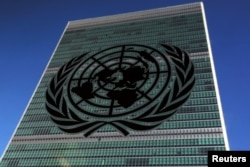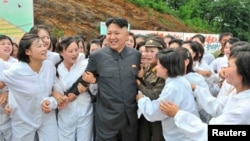The U.S. has issued more than 10,000 visas to North Koreans in the past 20 years, 18 of them this year from March to June, a Voice of America analysis of visa records shows.
There is no record of the whereabouts or activities in the United States of those who visit on business or tourism — a group accounting for as many as half the North Korean visitors last year. The State Department does not keep track visa applicants’ specific purposes for entering the U.S. — a piece of information typically gathered through visa applications and interviews, a State Department official told VOA.
“There’s no systematic way that that’s done,” the official said. “And it would be impossible to do because visas often are multiple-entry.”
The official said all visa applicants are subject to “very strict security screening standards,” and the U.S. issues visas to anyone who fulfills application requirements and is not determined to be a security threat. As the U.S. does not have official diplomatic relations with North Korea, the official said, all visa applications for North Koreans are issued outside the country.
So far this year, 18 North Koreans received visas from March to June, seven of them were business or tourist visas.
The U.S. State Department’s Bureau of Consular Affairs only began publishing monthly visa statistics in April.
Business or tourist visas
Last year, the U.S. issued 100 visas to North Koreans, 52 of which were business or tourist visas under the B-1/B-2 category, Voice of America found. The rest were diplomats.
VOA looked at yearly nonimmigrant visa statistics published by the Bureau of Consular Affairs from 1997 to 2016, as well as the monthly figures from this year. Immigrant visa weren’t included because the bureau was not able to produce immigrant visa records based on nationality. North Koreans who have renounced their citizenship — such as defectors — also weren’t included in the analysis.
From 1997 to 2001, the second half of Bill Clinton’s presidency, more than 1,200 North Koreans obtained business or tourist visas each year, with several dozen more getting student or diplomatic visas. Nine received work visas.
Other than diplomatic visas for officials stationed at the United Nations Headquarters in New York City, North Koreans have also been in the U.S. under an array of visas. Between 1997 and 2016, North Koreans received 281 F-1 student visas and 15 H-1B visas.
North Koreans have participated in educational and cultural exchange programs in the U.S. on topics from medicine to agriculture, Keith Luse, the executive director of the National Committee on North Korea, wrote to VOA.
Other North Korean visa recipients include athletes, artists, trainees, sailors on foreign-flagged ships, employees of international companies, transit visitors and a fiancé or fiancée of a U.S. citizen. (A list of U.S. visa categories can be accessed here.)
Upper echelons
North Korean citizens traveling or residing overseas are likely to be members of Pyongyang’s upper echelons, Greg Scarlatoiu, executive director of the Committee for Human Rights in North Korea, told VOA. North Korean leader Kim Jong Un, for instance, studied in Switzerland while his grandfather and father before him led the one-party state.
“They keep a low profile; they blend in,” Scarlatoiu said. “Probably in the case of students, their peers will not know that they’re from North Korea.”
Kim Byung-ki, a political science and international relations professor at Korea University in Seoul, told VOA that when abroad, North Koreans are tasked to gather information.
“The trip to the United States serves a very important purpose of understanding the society, how American people think about North Korea, learn more about their behavior, their taste, their political views, their social views,” Kim said. “I believe it is an important intelligence-gathering operation as it was the case in the Soviet Union times.”
US-North Korea tensions increase
Tensions between the United States and North Korea have ratcheted up since President Donald Trump took office. North Korea has fired 18 missiles this year, and the State Department has barred most Americans from traveling to North Korea after the death of Otto Warmbier. An American university student who was detained for 18 months, Warmbier was returned to the U.S. in a coma and died on June 19, 2017.
But, U.S. and North Korea relations have not always been as tense as they are today. And even now, contacts are occurring regularly between Joseph Yun, the U.S. envoy for North Korea policy, and Pak Song Il, a senior North Korean diplomat at the country’s U.N. mission, according to U.S. officials and others briefed on the process, according to the Associated Press. The officials weren’t authorized to discuss the confidential exchanges and spoke to the AP on condition of anonymity.
The Clinton administration, from 1993 to 2001, marked a relatively amicable period for U.S.-North Korea relations, as rapprochement efforts between the two governments were at their high point, Robert Gallucci, the chief U.S. negotiator during the North Korean nuclear crisis in the 1990s, said to VOA.
Gallucci led the brokering of the 1994 Agreed Framework, an agreement with North Korea that aimed to freeze its nuclear weapons program.
“I tend to think of the period as one in which relations improved mostly because we had thought we were successfully addressing the threat from the North Koreans’ developing nuclear weapons program in the 90s,” Gallucci said.
During Clinton’s presidency, North Korea endured a severe famine and was riddled with the imposing of sanctions on Pyongyang as the regime strived to circumvent the Non-Proliferation Treaty, which North Korea acceded in 1985 and left in 2003.
The relationship went downhill from the George W. Bush administration, which dubbed Pyongyang as an “axis of evil,” as it held a different view about the value of engagement with North Koreans, Gallucci said.
The Bush administration, along with China, Japan, Russia and the two Koreas, participated in the Six-Party Talks, a convention that aims to dismantle Pyongyang’s nuclear operations. The six countries last convened for the sixth round in 2008, when North Korea chose to reverse its dismantlement efforts.
Attempts to bring Pyongyang back to the table have been stymied since.








